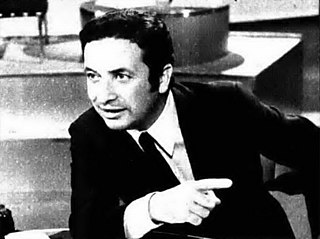
The Brady Bunch is an American sitcom created by Sherwood Schwartz that aired from September 26, 1969, to March 8, 1974, on ABC. The series revolves around a large blended family of six children, with three boys and three girls. After its cancellation in 1974, the series debuted in syndication in September 1975. Though it was never a ratings hit or a critical success during its original run, the program has since become a popular syndicated staple, especially among children and teenage viewers.

Rai – Radiotelevisione italiana, commercially styled as Rai since 2000 and known until 1954 as Radio Audizioni Italiane, is the national public broadcasting company of Italy, owned by the Ministry of Economy and Finance. Rai operates many terrestrial and subscription television channels and radio stations. It is one of the biggest broadcasters in Europe, and the biggest in Italy competing with Mediaset and other minor radio and television networks. Rai has a relatively high television audience share of 35.9%.

Domenico "Mimmo" Rotella was an Italian artist considered an important figure in post-war European art. Best known for his works of décollage and psychogeographics, made from torn advertising posters. He was associated to the Ultra-Lettrists an offshoot of Lettrism and later was a member of the Nouveau Réalisme, founded in 1960 by the art critic Pierre Restany.
The Editto bulgaro, also referred to as the "Bulgarian Diktat" or "Bulgarian Ukase" in Italian newspapers, was a statement of Silvio Berlusconi, at the time Prime Minister of Italy, about the behavior of three figures of Italian media and television – namely journalists Enzo Biagi and Michele Santoro and comedian Daniele Luttazzi – which was pronounced during a press conference with Simeon Saxe-Coburg-Gotha, at the time Prime Minister of Bulgaria, on 18 April 2002. It was soon followed by the removal of the three from national television.

Bruno Paolo Vespa is an Italian television and newspaper journalist. A former director of the Italian state-owned TV channel Rai 1's news programme TG1, Vespa is the founding host of the programme Porta a Porta, which has been broadcast without interruption on RAI channels since 1996.
Alberto Mantelli was an Italian musicologist and music critic.

Ente Italiano per le Audizioni Radiofoniche was the public service broadcaster in Fascist Italy and the only entity permitted to broadcast by the government.
Thema (Omaggio a Joyce) is an electroacoustic composition by Luciano Berio, for voice and tape. Composed in 1958 and 1959, it is based on the interpretative reading of the poem "Sirens" from chapter 11 of the novel Ulysses by James Joyce by Cathy Berberian and on the elaboration of her recorded voice by technological means.
Maria Luisa Altieri Biagi was an Italian scholar and writer.

Radiocorriere TV, formerly Radiocorriere (1930–1954) and Radio Orario (1925–1930), is an Italian-language listings magazine, with weekly print editions published in Italy between 1925 and 1995 under the press of RAI. It rebooted under publisher RCC Edizioni and owner Rai Trade with print editions from 1999–2008, then closed due to poor sales and reopened as an online magazine in 2012. Since 1995 it has also had occasional special-edition print runs under various publishers.

Luciano Rispoli was an Italian television and radio writer and presenter.
Nino Valeri was an Italian historian.

Open access to scholarly communication in Italy has grown since the early 2000s. During an academic conference in Messina in November 2004, Italian universities joined the Berlin Declaration on Open Access to Knowledge in the Sciences and Humanities, in Italy thereafter known as the "Declaration of Messina".
"Arriverà" is a song recorded by italian group Modà featuring Italian singer, Emma Marrone. It was released on 16 February 2011 through Ultrasuoni Records as the third single from Moda's fourth studio album Viva i romantici. The song was also included in Emma's album reissue A me piace così .
This is a list of Italian television related events from 1962.

Rai Teche is a company that manages all archived material that has been produced and broadcast by Italian national public broadcaster RAI throughout its history.
This is a list of Italian television related events from 1971.
Unione radiofonica italiana or URI, was an Italian radio broadcaster founded in Turin on 27 August 1924. It was the exclusive radio broadcaster of the Kingdom of Italy.
Nostradamus is a 1925 Italian silent historical film directed by Mario Roncoroni and starring Cello Bucchi in the title role of Nostradamus. It was one of the final film's released by the Unione Cinematografica Italiana which went bankrupt around this time.











